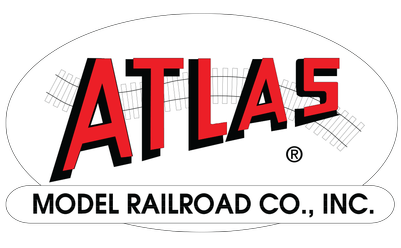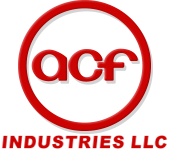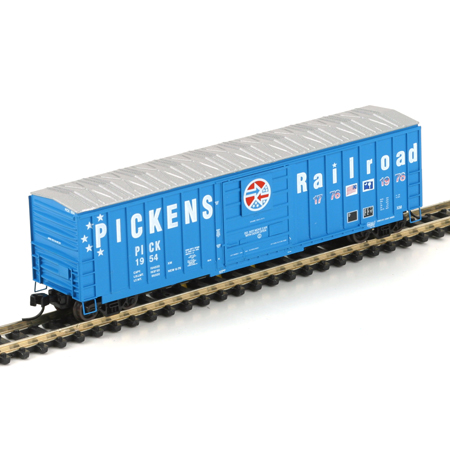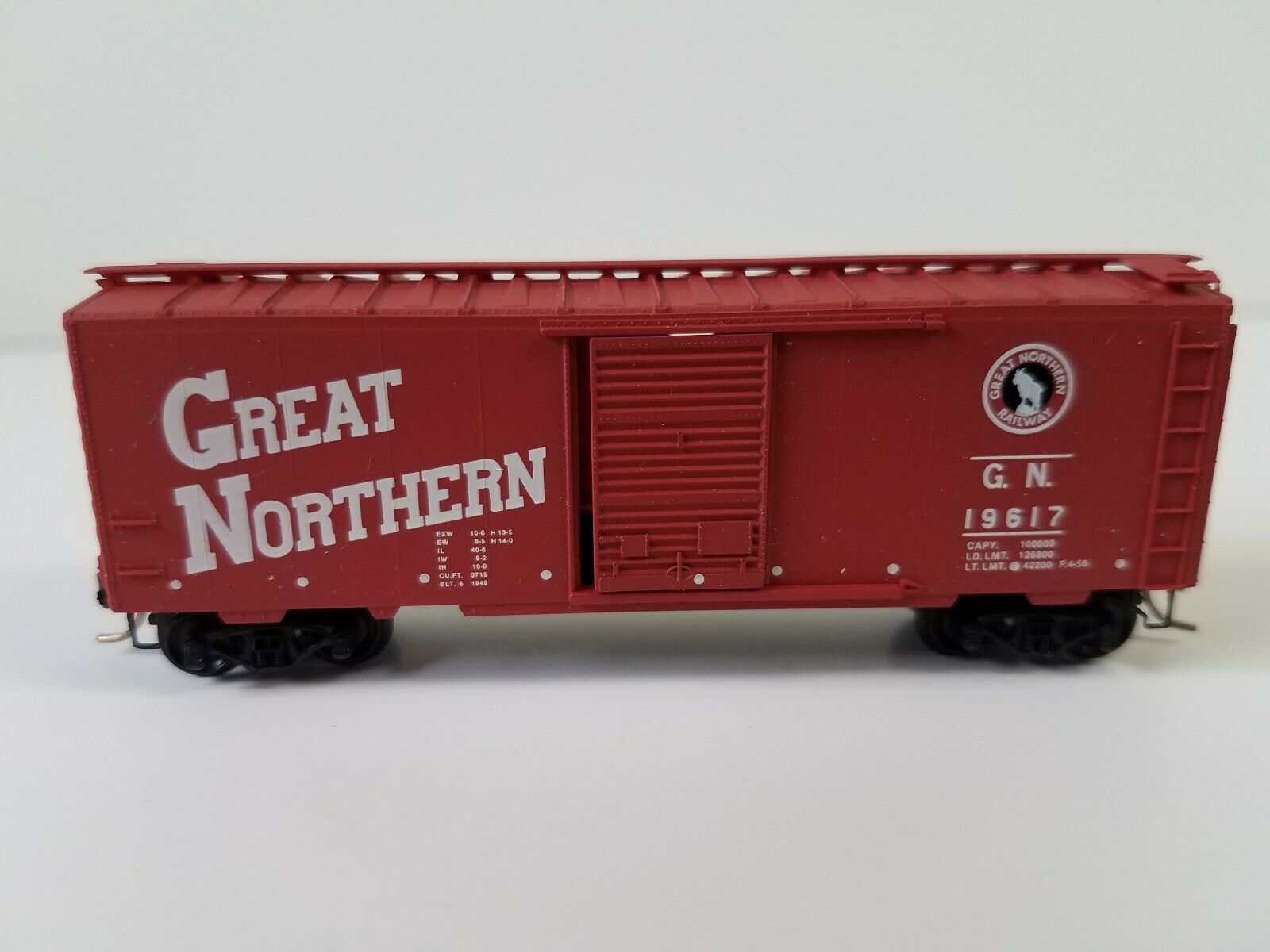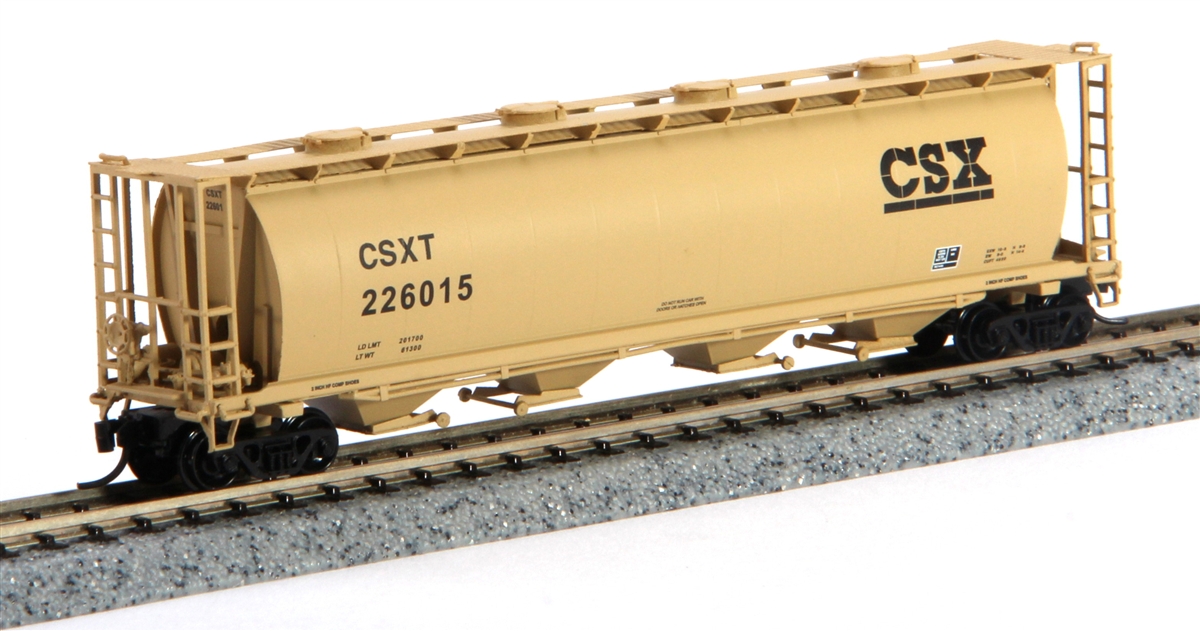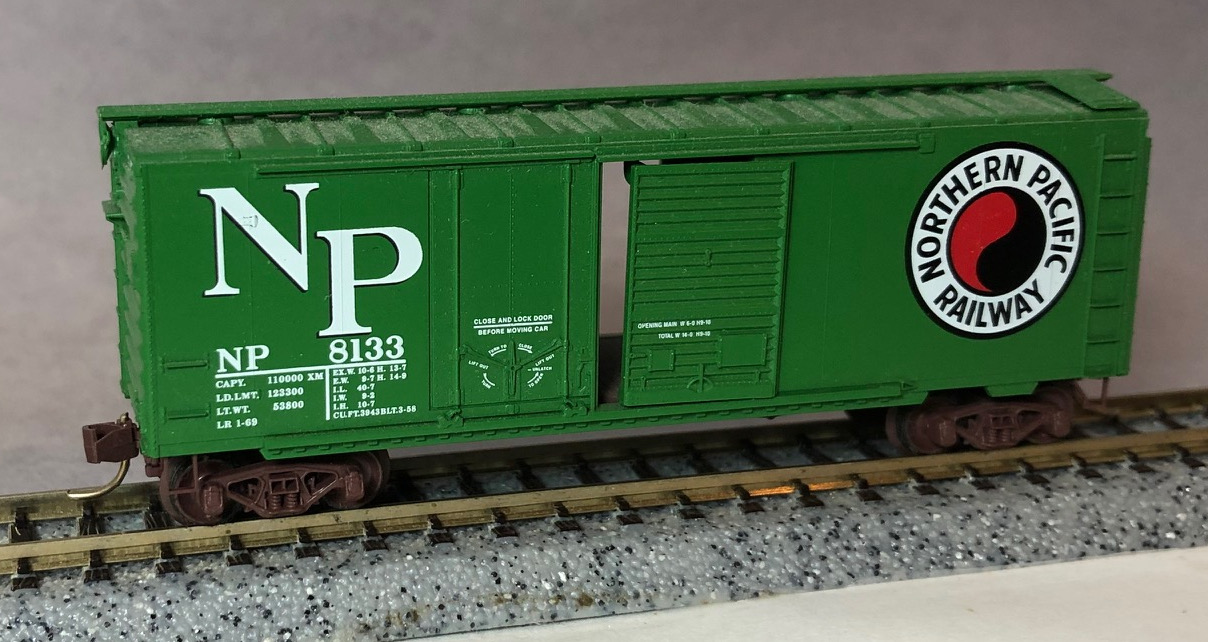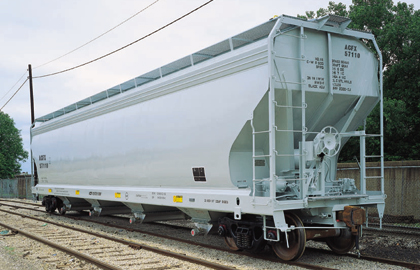Atlas - 3963 - Covered Hopper, 4-Bay, ACF Centerflow - Wisconsin Central - 83058
Click to see the details
market
Click to see the details
history
Click to see the details
collector
| Stock Number | 3963 |
| Original Retail Price | $8.75 |
| Brand | Atlas |
| Manufacturer | Atlas |
| Body Style | Atlas Covered Hopper 4-Bay ACF 5250 (Chinese Version) |
| Prototype Vehicle | Covered Hopper, 4-Bay, ACF Centerflow (Details) |
| Road or Company Name | Wisconsin Central (Details) |
| Reporting Marks | WC |
| Road or Reporting Number | 83058 |
| Paint Color(s) | Gray |
| Print Color(s) | Red and Black |
| Coupler Type | MT Magne-Matic Knuckle |
| Wheel Type | Injection Molded Plastic |
| Wheel Profile | Small Flange (Low Profile) |
| Release Date | 1996-01-01 |
| Item Category | Rolling Stock (Freight) |
| Model Type | Covered Hopper |
| Model Subtype | 4-Bay |
| Model Variety | ACF 5250 |
| Prototype Region | North America |
| Prototype Era | NA Era IV: 2nd Gen Diesel (1958 - 1978) |
| Scale | 1/160 |
Specific Item Information:
Test
Model Information:
This model was originally introduced in 1993. It is somewhat similar to the earlier Roco/Atlas produced 3700-series model which was still available in the 1990s when this new model became available. The earlier models can be distinguished from this one because they are stamped either "Austria" or "Atlas USA" on the underframe. The later models can also be identified by the angled stirrups at each end (as opposed to squared off ones on the Austrian tooling). Lastly, the Chinese versions have several ridges along the side towards the roof-line in a 'washboard' pattern.
This new Chinese production model was specifically identified as modeling the ACF 5250 c.f. Centerflow hopper When this model appeared in the 1994 Atlas catalog it was on the next page after the earlier tooling (apparently many of the old models were still in the warehouse). The new ones were marketed as 'ACF 4-Bay Centerflow® Hopper - All New Mold Work!" as opposed to the older models which were labeled as "ACF 4-Bay Centerflow® Covered Hopper". Atlas' model represents the post-1971 version of the ACF 5250 4-Bay Covered Hopper Car that was used by railroads and private shippers across North America.
This new Chinese production model was specifically identified as modeling the ACF 5250 c.f. Centerflow hopper When this model appeared in the 1994 Atlas catalog it was on the next page after the earlier tooling (apparently many of the old models were still in the warehouse). The new ones were marketed as 'ACF 4-Bay Centerflow® Hopper - All New Mold Work!" as opposed to the older models which were labeled as "ACF 4-Bay Centerflow® Covered Hopper". Atlas' model represents the post-1971 version of the ACF 5250 4-Bay Covered Hopper Car that was used by railroads and private shippers across North America.
Prototype History:
Contemporary 2-bay covered hoppers, like ACF's Centerflows, were 100-ton cars designed to haul dense loads, like cement. Their larger 3 and 4-bay brethren, while usually still having 100 ton capacities, were designed for lighter-density loads, like grain or flour. Their sizes had to do with the fact that a low-density product like grain will "cube out" the cubic capacity of a smaller 2-bay car way before you hit the cars' tonnage rating. Conversely, load a 3 or 4-bay covered hopper to its cubic maximum with a dense product like cement, and you'll wind up with a seriously overloaded car tonnage wise. In short, keep the smaller 2-bay cars for heavy commodities, and keep the larger cars for lighter loads like grains, sugar, flour, etc.
Road Name History:
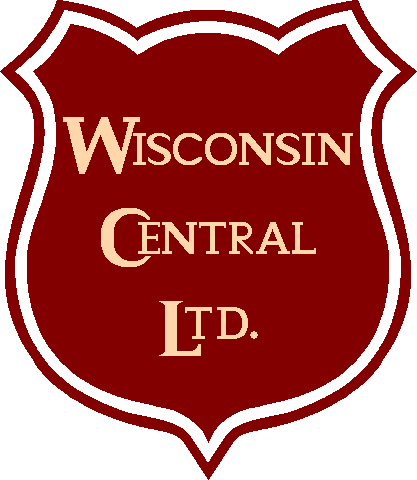 Wisconsin Central Ltd. (reporting mark WC) is a railroad subsidiary of the Canadian National Railway. At one time, its parent Wisconsin Central Transportation Corporation owned or operated railroads in the United States, Canada (Algoma Central Railway), the United Kingdom (English Welsh & Scottish), New Zealand (Tranz Rail), and Australia (Australian Transport Network).
Wisconsin Central Ltd. (reporting mark WC) is a railroad subsidiary of the Canadian National Railway. At one time, its parent Wisconsin Central Transportation Corporation owned or operated railroads in the United States, Canada (Algoma Central Railway), the United Kingdom (English Welsh & Scottish), New Zealand (Tranz Rail), and Australia (Australian Transport Network).
Wisconsin Central Ltd. (WC) started in US in the mid-1980s using most of the original Wisconsin Central Railway's rights of way and some former Milwaukee Road rights of way after the Soo Line Railroad acquired the Wisconsin, Illinois, Indiana, Missouri and Minnesota holdings of the bankrupt Milwaukee Road and divested its older railway trackage in Wisconsin. In 1993 the Wisconsin Central also acquired the Green Bay and Western Railroad and the Fox River Valley Railroad.
At the time of its sale to Canadian National, Wisconsin Central operated over 2,850 miles (4,590 km) of track in the Great Lakes region. The railroad extended from Chicago into and through Wisconsin to Minneapolis/St. Paul and Duluth, Minnesota, to Sault Ste Marie, Michigan, and north (through the Algoma Central Railway) to Hearst, Ontario.
A condition of Soo Line’s acquisition of Milwaukee Road was that they had to sell a number of lines in Wisconsin and Michigan’s Upper Peninsula. They established Lake States Transportation to separate these lines from the rest of Soo Line. In 1987, Lake States was sold to a group of investors and Wisconsin Central was born. Much of the track had belonged to the original Wisconsin Central, a Soo subsidiary which had been merged into Soo in 1960. In 1993, WC acquired Fox River Valley Railroad and Green Bay & Western. In 1995, they founded a Canadian subsidiary and acquired the Algoma Central. Then in 1997, they picked up another 200 miles of former C&NW line running north from Green Bay from Union Pacific. At this point, the 2,850 mile WC (between GM&O and Erie Lackawanna in relative size) linked: Chicago, Milwaukee, Green Bay, Minneapolis/St.Paul, Duluth/Superior, then down Michigan’s Upper Peninsula to Sault Ste. Marie where they connected to Algoma Central north to Hearst, Ontario. WC’s parent company also went on a buying spree of railroads in other countries including New Zealand, Britain, and Australia. Wisconsin Central was sold to Canadian National in 2001. It operates as a paper railroad under CN’s flag today.
From Wikipedia and Bluford Shops

Wisconsin Central Ltd. (WC) started in US in the mid-1980s using most of the original Wisconsin Central Railway's rights of way and some former Milwaukee Road rights of way after the Soo Line Railroad acquired the Wisconsin, Illinois, Indiana, Missouri and Minnesota holdings of the bankrupt Milwaukee Road and divested its older railway trackage in Wisconsin. In 1993 the Wisconsin Central also acquired the Green Bay and Western Railroad and the Fox River Valley Railroad.
At the time of its sale to Canadian National, Wisconsin Central operated over 2,850 miles (4,590 km) of track in the Great Lakes region. The railroad extended from Chicago into and through Wisconsin to Minneapolis/St. Paul and Duluth, Minnesota, to Sault Ste Marie, Michigan, and north (through the Algoma Central Railway) to Hearst, Ontario.
A condition of Soo Line’s acquisition of Milwaukee Road was that they had to sell a number of lines in Wisconsin and Michigan’s Upper Peninsula. They established Lake States Transportation to separate these lines from the rest of Soo Line. In 1987, Lake States was sold to a group of investors and Wisconsin Central was born. Much of the track had belonged to the original Wisconsin Central, a Soo subsidiary which had been merged into Soo in 1960. In 1993, WC acquired Fox River Valley Railroad and Green Bay & Western. In 1995, they founded a Canadian subsidiary and acquired the Algoma Central. Then in 1997, they picked up another 200 miles of former C&NW line running north from Green Bay from Union Pacific. At this point, the 2,850 mile WC (between GM&O and Erie Lackawanna in relative size) linked: Chicago, Milwaukee, Green Bay, Minneapolis/St.Paul, Duluth/Superior, then down Michigan’s Upper Peninsula to Sault Ste. Marie where they connected to Algoma Central north to Hearst, Ontario. WC’s parent company also went on a buying spree of railroads in other countries including New Zealand, Britain, and Australia. Wisconsin Central was sold to Canadian National in 2001. It operates as a paper railroad under CN’s flag today.
From Wikipedia and Bluford Shops
Brand/Importer Information:
In 1924 Stephan Schaffan, Sr. founded the Atlas Tool Company in Newark, New Jersey. In 1933 his son, Stephan Schaffan, Jr., came to work for his father at the age of sixteen. Steve Jr. built model airplanes as a hobby and frequented a local hobby shop. Being an enterprising young man, he would often ask the owner if there was anything he could do to earn some extra spending money. Tired of listening to his requests, the hobby-store owner threw some model railroad track parts his way and said, "Here, see if you can improve on this".
In those days, railroad modelers had to assemble and build everything from scratch. Steve Jr. created a "switch kit" which sold so well, that the entire family worked on them in the basement at night, while doing business as usual in the machine shop during the day.
Subsequently, Steve Jr. engineered the stapling of rail to fiber track, along with inventing the first practical rail joiner and pre-assembled turnouts and flexible track. All of these products, and more, helped to popularize model railroading and assisted in the creation of a mass-market hobby. The budding entrepreneur quickly outgrew the limitations of a basement and small garage operation. Realizing they could actually make a living selling track and related products, Steve and his father had the first factory built in Hillside, New Jersey at 413 Florence Avenue in 1947. On September 30, 1949, the Atlas Tool Company was officially incorporated as a New Jersey company.
In 1985, Steve was honored posthumously for his inventions by the Model Railroad Industry Association and was inducted into the Model Railroad Industry Hall of Fame in Baltimore, Maryland. In addition, Steve was nominated and entered into the National Model Railroad Association Pioneers of Model Railroading in 1995.
In the early 1990s, the Atlas Tool Company changed its name to Atlas Model Railroad Company, Inc.
In those days, railroad modelers had to assemble and build everything from scratch. Steve Jr. created a "switch kit" which sold so well, that the entire family worked on them in the basement at night, while doing business as usual in the machine shop during the day.
Subsequently, Steve Jr. engineered the stapling of rail to fiber track, along with inventing the first practical rail joiner and pre-assembled turnouts and flexible track. All of these products, and more, helped to popularize model railroading and assisted in the creation of a mass-market hobby. The budding entrepreneur quickly outgrew the limitations of a basement and small garage operation. Realizing they could actually make a living selling track and related products, Steve and his father had the first factory built in Hillside, New Jersey at 413 Florence Avenue in 1947. On September 30, 1949, the Atlas Tool Company was officially incorporated as a New Jersey company.
In 1985, Steve was honored posthumously for his inventions by the Model Railroad Industry Association and was inducted into the Model Railroad Industry Hall of Fame in Baltimore, Maryland. In addition, Steve was nominated and entered into the National Model Railroad Association Pioneers of Model Railroading in 1995.
In the early 1990s, the Atlas Tool Company changed its name to Atlas Model Railroad Company, Inc.
Item created by: gdm
on 2018-02-01 10:10:09
Last edited by: CNW400 on 2020-09-01 11:28:50
If you see errors or missing data in this entry, please feel free to log in and edit it. Anyone with a Gmail account can log in instantly.
Last edited by: CNW400 on 2020-09-01 11:28:50
If you see errors or missing data in this entry, please feel free to log in and edit it. Anyone with a Gmail account can log in instantly.



